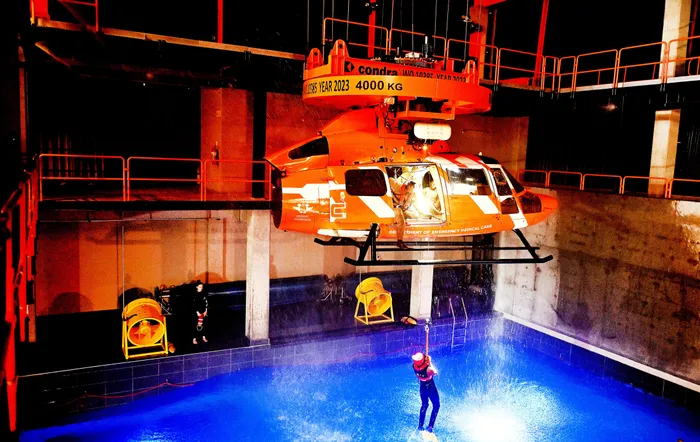UJ launches Africa’s first Advanced Rescue Simulation Centre

Simulation of a wet hoisting operation.
Image: University of Johannesburg
The University of Johannesburg (UJ) has made history with the launch of Africa’s first Advanced Rescue Simulation Centre, a state-of-the-art facility set to transform emergency and disaster response training across the continent.
The four-storey, 3 000m² centre, located at UJ’s Doornfontein Campus, was officially unveiled on yesterday. Designed and commissioned by the Department of Emergency Medical Care (EMC) in UJ’s Faculty of Health Sciences, the facility represents an innovative leap in emergency response education and research, firmly positioning the University at the forefront of rescue training, simulation and innovation.
Speaking ahead of the launch, UJ vice-chancellor and principal, Professor Letlhokwa George Mpedi, said the centre plays a strategic role in strengthening national preparedness and advancing professional rescue capabilities.
“With this state-of-the-art Rescue Simulation Centre, we are redefining how emergency response training is delivered on the continent. There is no longer a need to travel abroad for world-class rescue training. It is right here at UJ. This facility serves not only our students but the nation. As we celebrate UJ’s 20th anniversary, this milestone reflects our steadfast commitment to innovation, excellence, and nation-building. By investing in safety and skills, we save lives and strengthen our country’s readiness for the challenges that lie ahead,” said Prof Mpedi.
He added that the Centre provides diverse, cost-effective and comprehensive learning experiences, all in one facility.
“This project is about accessibility, quality, and national impact,” he said. “We are creating opportunities for students, professionals, and industries to gain world-class training locally, while building the capacity of South Africa and the broader continent to respond effectively to future emergencies.”

Chancellor Dr Phumzile Mlambo-Ngcuka, vice-chancellor and principal Prof Letlhokwa Mpedi and Deputy Minister of Employment and Labour Judith Nemadzinga-Tshabalala minutes before officially opening the centre.
Image: University of Johannesburg
Supported by the Department of Higher Education and Training, the UJ Rescue Simulation Centre marks a major step forward in training professionals to meet the growing complexities of modern disasters. It offers realistic, high-fidelity simulated environments to strengthen preparedness, coordination, and technical expertise.
Purpose-built for realism and safety, the facility includes:
A five-metre-deep survival pool for aquatic and helicopter underwater egress training (HUET);
A helicopter simulator for “wet” and “dry” hoisting operations;
Rotor-wing aircraft safety and patient-care simulation zones;
A basement-level urban search and rescue area featuring configurable confined-space tunnels, shoring systems, and heavy-lifting jigs;
A 30-seater aircraft fuselage for mass casualty simulations; and
A three-metre-deep trench rescue simulator with environmental systems that replicate rain, wind, waves, and darkness for fully immersive training.
According to Connor Hartnady, a lecturer in UJ’s Department of Emergency Medical Care and one of South Africa’s experienced emergency response specialists, the Centre bridges a crucial gap between theory and real-world practice.
“This facility equips teams with the resources and practical experience they need to respond effectively, save lives, and manage risk,” Hartnady said. “Natural hazards are increasing, urbanisation is evolving rapidly, and emergencies are becoming more complex. This centre prepares responders not only for South African conditions but for challenges across the continent.”
Government, civil society, and industry partners attended the launch, extending messages of support. Among them, Deputy Minister of Employment and Labour, Judith Nemadzinga-Tshabalala, said the initiative represents more than an institutional milestone.
“UJ’s Rescue Centre responds to the urgent need for environmental protection, emergency preparedness, and sustainable economic development. Through education, training, and research, it will expand South Africa’s emergency response capacity, strengthen collaboration between institutions, and enhance regional leadership in rescue operations. The establishment of this Centre is, therefore, not merely an institutional achievement, but a national pledge to safety, dignity, and resilience in the face of increasing global and environmental challenges.”
Prof Mpedi concluded: “With the launch of this world-class facility, UJ continues to reaffirm its commitment to advancing the Fourth Industrial Revolution (4IR) in education, while addressing the urgent societal need for safety, innovation, and sustainability. UJ Rescue Simulation Centre stands as a symbol of hope, resilience, and progress, one that will shape a new generation of African rescue professionals equipped to confront the challenges of tomorrow.”
Related Topics: